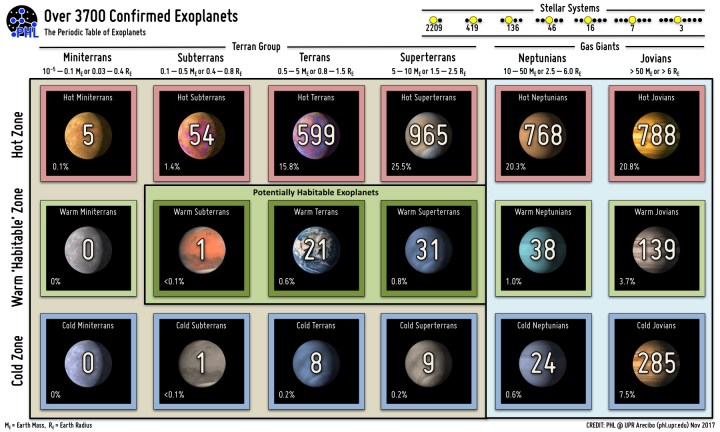
To categorize all these new discoveries, astronomer Abel Méndez from the Planetary Habitability Laboratory has created a Periodic Table of Exoplanets with 18 categories based on size, temperature, and composition.
On the left side, the planets are slotted into one of three zones, roughly based on how water would exist on the surface as vapor, liquid, or ice. The warm or “habitable” zone exoplanets hold the most interest for researchers, as those are the locations most likely to support life. “Unfortunately, we don’t know yet if they also have the right amount of water (e.g. oceans) or the right atmosphere for life too,” Méndez explained to Gizmodo.
Across the top, the planets are split between rocky “Terran” and gaseous “Gas Giants.” Those two designations are further subdivided by size, ranging from Miniterrans (like our moon) to Jovians (such as Jupiter or Saturn).
The numbers show how many exoplanets of each type have been discovered, as well as the percentage of the total. You can see that 21 Warm Terrans were discovered that are the most similar to our Earth so far, or about 0.6% of the total.
Along the upper right, the numbers indicate how many stellar systems we’ve discovered, and how may exoplanets each one contains. For example, we’ve 16 systems have been uncovered that contain seven planets. Most stellar systems that astronomers have found contain at least one planet.

For comparison, the Solar System Periodic Table categorizes the 82 planets, dwarf-planets, and moons in our own system whizzing around the sun or orbiting various planets.
The majority of the discoveries are hot planets, but that’s likely because they’re much easier to detect, and thousands more are out there awaiting discovery. “I’m overwhelmed by the number and diversity of planets in the stars around us,” Méndez said. “So many places to explore in our own Solar System, but much more is waiting for us beyond.”
Editors' Recommendations
- Evidence of a possible exoplanet in another galaxy found for the first time
- Hubble spots distant exoplanet that could be equivalent to Planet Nine
- Spooky NASA posters highlight the mysterious world of exoplanets


